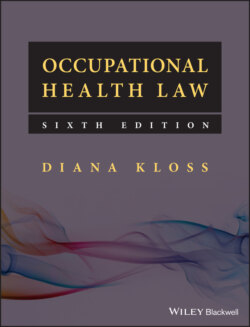Читать книгу Occupational Health Law - Diana Kloss - Страница 37
1.4 The Employment Medical Advisory Service and Appointed Doctors
ОглавлениеIn 1833 and 1844 the Factory Acts required child workers to be examined by a local surgeon or physician to assess whether they were under the legal minimum working age (nine). The 1855 Factory Act conferred on these Certifying Factory Surgeons the task of certifying that young people were not incapacitated for work and of investigating industrial accidents. The doctor was independent both of the employer and of the employee, though paid by the factory owner. Later in the century, legislation required the Certifying Factory Surgeons also to investigate cases of industrial disease. In addition, employers were compelled to pay Appointed Surgeons to undertake regular medical examination of those working with specified substances like lead and phosphorus. The first full‐time Medical Inspector of Factories was appointed in 1898.
Part‐time medical practitioners have, therefore, conducted medical examinations in industry for more than a century. They now operate under the supervision of full‐time specialists in occupational medicine, the Employment Medical Advisory Service (EMAS) and are called Appointed Doctors (ADs). Their principal function is to undertake examinations of workers in the workplace and to assess their fitness for work when the employer is bound by statute to carry out regular health surveillance. The ADs are appointed by the Health and Safety Executive through EMAS in respect of a particular company or companies and premises. EMAS is able to ask for evidence of occupational health qualifications and experience when making appointments, though these are not mandatory legal requirements. The ADs are obliged to comply with both the clinical and administrative procedures set by EMAS; they are subject to inspection by Employment Medical Advisers. It is very important that proper clinical records are kept and statistical returns made to EMAS. If the work of the AD is unsatisfactory, his appointment may be revoked without a reason being stated or an explanation given. The employer has to pay fees for medical surveillance required by law.
The functions of EMAS are laid down in section 55 of the Health and Safety at Work Act. It undertakes the following responsibilities:
Advice to the inspectorate on the occupational health aspects of Regulations and Approved Codes of Practice (Chapter 5).
Regular examinations of persons employed on known hazardous operations.
Other medical examinations, investigations and surveys. An Adviser has power to require an employer to permit him to carry out a medical examination of any employee whose health the Adviser believes may be in danger because of his work.
Advice to the HSE, employers, trade unions and others on the occupational health aspects of poisonous substances, immunological disorders, physical hazards, dust, and mental stress, including setting standards of exposure to harmful processes and substances.
Research into occupational health.
Advice on the provision of occupational health and first aid services.
Advice on the medical aspects of rehabilitation and training for and placement in employment.
EMAS employs both doctors (EMAs) and nurses (Inspectors of Health and Safety (Occupational Health)) as well as support staff. It also provides the secretariat for two of the Health and Safety Executive’s Advisory Committees:
1 the Workplace Health Expert Committee (WHEC). This committee was set up in 2015 under the chairmanship of Professor Sir Anthony Newman Taylor. Its remit is to give an independent expert opinion to the HSE on new, emerging and existing workplace health issues and the quality and relevance of the evidence base on workplace health issues.
2 the Advisory Committee on Dangerous Pathogens (ACDP).
